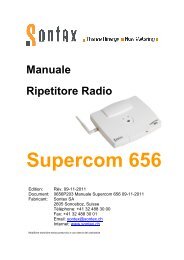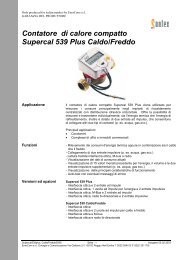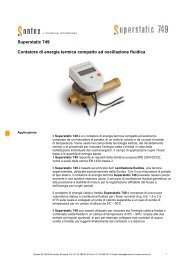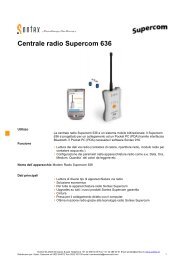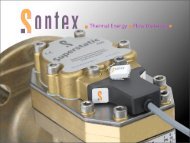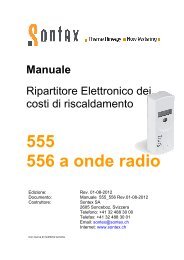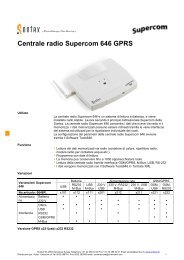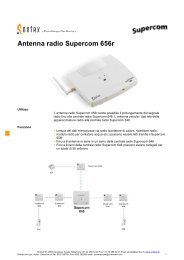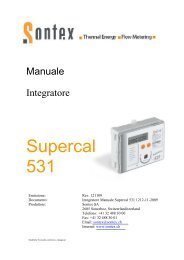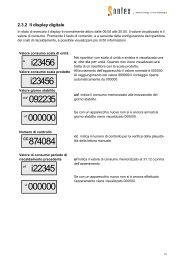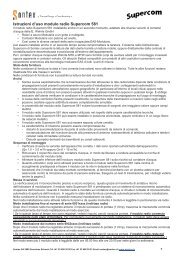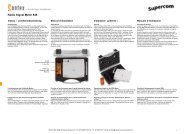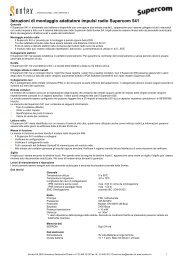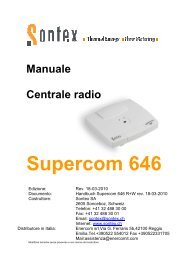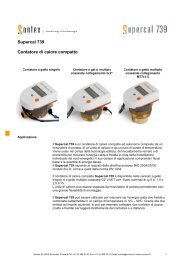Manuale Supercom 646 GPRS - Enercom Italia > Contabilizzazione ...
Manuale Supercom 646 GPRS - Enercom Italia > Contabilizzazione ...
Manuale Supercom 646 GPRS - Enercom Italia > Contabilizzazione ...
Create successful ePaper yourself
Turn your PDF publications into a flip-book with our unique Google optimized e-Paper software.
<strong>Manuale</strong><br />
Centrale radio <strong>GPRS</strong><br />
<strong>Supercom</strong> <strong>646</strong><br />
Edizione: Rev. 04.02.2011<br />
Documento: Handbuch <strong>Supercom</strong> <strong>646</strong> <strong>GPRS</strong> rev. 04.02.2011<br />
Costruttore: Sontex SA<br />
2605 Sonceboz, Schweiz<br />
Telefon: +41 32 488 30 00<br />
Fax: +41 32 488 30 01<br />
Email: sontex@sontex.ch<br />
Internet: www.sontex.ch<br />
Distributore in <strong>Italia</strong>: <strong>Enercom</strong> srl,Via G. Ferraris 5C,42122 Reggio<br />
Emilia.Tel.+390522 558791 Fax +390522 392069<br />
Mail:commerciale@enercomit.com<br />
Modifiche tecniche senza preavviso e con riserva del costruttore
Indice<br />
1. Generale .................................................................................................. 4<br />
1.1 Introduzione .................................................................................................................. 4<br />
1.2 Campo di utilizzo della centrale radio ............................................................................ 4<br />
2. Contenuto della fornitura ....................................................................... 5<br />
3. Installazione della centrale radio ........................................................... 5<br />
3.1 Montaggio dell´antenna ................................................................................................. 5<br />
3.2 Montaggio della centrale radio .................................................................................................. 5<br />
3.2.1 Montaggio a parete .......................................................................................................... 5<br />
3.3 Alimentazione ........................................................................................................................... 5<br />
3.3.1 Attivazione dell´alimentazione<br />
3.3.2 Attivazione della batteria sulla scheda principale ...................................................................... 5<br />
3.3.3 Batteria-Modulo rete per 52 registrazioni all´anno ..................................................................... 7<br />
3.3.4 Modulo rete .............................................................................................................................. 7<br />
3.3.5 Modulo <strong>GPRS</strong> .......................................................................................................................... 6<br />
3.3.6 Per l´utilizzo del modulo <strong>GPRS</strong> e´necessario abbonamento telefono ...................................... 8<br />
3.3.7 Modulo M-Bus<br />
3.4 Chiudere e sigillare l´apparecchio ................................................................................. 9<br />
3.5 Parametraggio della centrale radio ........................................................................................... 9<br />
4. Memorizzazione dei dati ed intervalli delle apparecchiature<br />
radio ....................................................................................................... 11<br />
4.1 Piano lettura radio ....................................................................................................... 11<br />
4.2 Memorizzazione die dati .............................................................................................. 12<br />
5. Descrizione dei LED ............................................................................. 11<br />
5.1 Indicatore LED ............................................................................................................ 11<br />
5.2 Modulo <strong>GPRS</strong>, Descrizione LED ................................................................................. 12<br />
5.3 Problemi con l´alimentazione .................................................................................................. 12<br />
5.3.1 Interruzione alimentazione oppure batteria debole<br />
5.3.2 Batteria per l´alimentazione oppure batteria Backup scarica: .................................................. 12<br />
6. Indicazioni generali .............................................................................. 13<br />
6.1.1 Alimentazione staccata oppure batteria scarica ...................................................................... 13<br />
6.1.2 Smaltimento batteria ........................................................ Errore. Il segnalibro non è definito.<br />
6.1.3 Cambio della batteria .............................................................................................................. 14<br />
6.1.4 Collegamento elettrico del modulo rete ................................................................................... 14<br />
6.1.5 Indicazioni di sicurezza<br />
6.2 Sigillo…. ...................................................................................................................... 14<br />
6.3 Dati tecnici ................................................................................................................... 15<br />
6.4 Dimensoni ................................................................................................................... 16<br />
<strong>Manuale</strong> <strong>Supercom</strong> <strong>646</strong><strong>GPRS</strong> 11062011<br />
2
7. M-Bus Protocollo di comunicazione ................................................... 20<br />
7.1 Introduzione ................................................................................................................ 20<br />
7.2 Divisione della memoria della centrale ........................................................................ 20<br />
7.3 Principio di lettura ........................................................................................................ 20<br />
7.3.1 Descrizione per la lettura della configurazione e della lista apparecchiature della<br />
centrale radio .......................................................................................................................... 21<br />
7.3.2 Richiesta dei dati letti e memorizzati delle apparecchiature radio ........................................... 26<br />
7.4 Principio di scrittura della centrale radio ...................................................................... 30<br />
7.4.1 Modifica della configurazione della centrale radio ................................................................... 30<br />
7.4.2 Password della centrale radio ................................................................................................. 31<br />
7.4.3 Aggiungere un apparecchio nella lista delle apparecchiature.................................................. 31<br />
7.4.4 Modifica della lista apparecchiature ........................................................................................ 31<br />
8. Utilizzo ................................................................................................... 32<br />
8.1 Attualizzare il Firmware .............................................................................................. 32<br />
9. Allegato A .............................................................................................. 33<br />
9.1 Leggere la configurazione nella centrale radio ............................................................ 33<br />
9.2 Leggere le liste delle apparecchiature memorizzate nella centrale radio .................... 34<br />
9.3 Leggere i dati delle apparecchiature lette e memorizzate nella centrale radio ............ 35<br />
10. Allegato B .............................................................................................. 35<br />
10.1 Principio di scrittura oppure configurazione nella centrale radio ................................. 35<br />
11. Allegato C………………………………………………………………..........37<br />
11.1 Amplificatore radio <strong>Supercom</strong> 656R 37<br />
12. Allegato D……………………………………………………………………...38<br />
12.1 Parametraggio 38<br />
12.1.1 PIN-Code 38<br />
12.1.2 Numero richiamo 38<br />
12.1.3 Password per i comandi SMS 38<br />
12.1.4 Accesso <strong>GPRS</strong> 39<br />
12.1.5 Accesso FTP 39<br />
12.1.6 Accesso al HTTP Time Server 39<br />
12.1 SMS 40<br />
12.2.1 Syntax generale 40<br />
12.2.2 Comandi 41<br />
Allegato E…………………………………………………………………………….44<br />
13. Formato BIN File 44<br />
<strong>Manuale</strong> <strong>Supercom</strong> <strong>646</strong><strong>GPRS</strong> 11062011<br />
3
1. Generale<br />
1.1 Introduzione<br />
In questo manuale viene descritta la funzione e l´utilizzo del <strong>Supercom</strong> <strong>646</strong>. Il manuale e´destinato a<br />
tecnici.<br />
1.2 Campo di utilizzo della centrale radio<br />
La centrale radio <strong>Supercom</strong> <strong>646</strong> concentra i dati che riceve via radio dalle apparecchiature dotate con il<br />
sistema radio. La centrale radio <strong>Supercom</strong> puo´essere letta tramite USB oppure interfaccia RS232 ,<br />
ottico, tramite M-Bus oppure GSM/<strong>GPRS</strong>. Possono essere lette le seguenti apparecchiature Sontex<br />
tramite radio:<br />
� Ripartitore radio 502s / 552 / 556<br />
� Distributore acqua 590<br />
� Contatore di calore compatto Supercal 539 con l´opzione radio<br />
� Unita´di calcolo Supercal 531 con l´opzione radio<br />
� Modulo radio 540 (max. 2 entrate) / <strong>Supercom</strong> 541<br />
� Modulo radio <strong>Supercom</strong> 580 / 581<br />
Le periferie della centrale radio sono predisposte per un collegamento ad un pc tramite usb, rs 232,<br />
ottica,mbus,gsm/gprs. Il <strong>Supercom</strong> <strong>646</strong> puo´ricevere i dati da diverse utenze. Il modem radio lavora su<br />
una frequenza di 433.82 MHz ed appoggia i protocollo MFD e Radiant 0.<br />
PC<br />
USB,<br />
RS232,<br />
Optical,<br />
GSM/<strong>GPRS</strong><br />
<strong>646</strong><br />
MFD Radio Network<br />
580<br />
581<br />
590<br />
556<br />
539<br />
539+<br />
531<br />
552<br />
502<br />
540<br />
433MHz<br />
<strong>Manuale</strong> <strong>Supercom</strong> <strong>646</strong><strong>GPRS</strong> 11062011<br />
M-Bus<br />
central<br />
M-Bus<br />
Repeater<br />
(656)<br />
4
2. Contenuto della fornitura<br />
Il contenuto della fornitura e´come di seguito:<br />
� Centrale radio <strong>Supercom</strong> <strong>646</strong> con modulo di alimentazione<br />
� 1 Cassetta in plastica in DIN<br />
� 4 Viti e 4 piedini per il montaggio a parete<br />
� 2 sigilli per il coperchio<br />
� 1 ponte per l´attivazione della batteria<br />
� <strong>Manuale</strong><br />
� CD con:<br />
Software Tools<strong>646</strong><br />
<strong>Manuale</strong> Tools<strong>646</strong> (PDF)<br />
3. Installazione della centrale radio<br />
3.1 Montaggio dell´antenna<br />
Prendete l´antenna dal sacchetto di plastica ed avvitatelo sulla presa SMA nella parte sinistra<br />
dell´apparecchio. Si assicuri che l´antenna e´fissata bene.<br />
3.2 Montaggio della centrale radio<br />
3.2.1 Montaggio a parete<br />
La centrale radio <strong>Supercom</strong> <strong>646</strong> puo´essere montata in orizzontale oppure alla parete utilizzando gli<br />
accessori forniti con l´apparecchiatura. Il coperchio della parte inferiore e´da rimuovere aprendo la vite.<br />
Rimuovere il coperchio superiore e fissare la parte inferiore dove si trova l´elettronica con le quattro viti.<br />
La centrale puo´essere montata anche su una barra DIN.( vedi pagina 15)<br />
3.3 Alimentazione<br />
3.3.1 Attivazione dell´alimentazione<br />
Il cavo di alimentazione oppure la batteria deve essere inserita nella scheda principale.<br />
3.3.2 Attivazione della batteria sulla scheda principale<br />
Durante l´istallazione della centrale devono essere collegate le batterie. Per questo<br />
deve essere inserito il ponte sui due pins sulla prima fila della scheda principale.<br />
Non appena e´inserito il ponte la centrale e´alimentata tramite le batterie ed<br />
i LED in verde ed arancione si accendono contemporaneamente tre volte. Da<br />
questo momento la centrale puo´essere configurata tramite il software di configurazione.<br />
Nella centrale radio con modulo <strong>GPRS</strong> deve essere prima inserita la scheda<br />
SIM e poi rimosso il Jumper dalla posizione 2 alla posizione 1 e la successiva<br />
attivazione della batteria<br />
3.3.3 Il modulo batteria per 52 memorizzazioni all´anno<br />
Il modulo batteria e´configurato per massimo 52 memorizzazioni in un anno per una durata di 10 anni<br />
per la ricezione di 500 ripartitori oppure 24 memorizzazioni all´anno per 1000 ripartitori.<br />
<strong>Manuale</strong> <strong>Supercom</strong> <strong>646</strong><strong>GPRS</strong> 11062011<br />
5
3.3.4 Modulo alimentazione rete<br />
Inserire il cavo elettrico nella parte inferiore nel foro previsto e collegarlo all´alimentatore rete. Il modulo<br />
rete viene collegato tramite un cavo alla scheda principale della centrale. E´necessaria l´alimentazione<br />
rete nel caso di utilizzo di moduli GSM/<strong>GPRS</strong>. Sulla scheda principale si trova una batteria backup nel<br />
caso di interruzione dell´alimentazione.<br />
3.3.5 GSM/<strong>GPRS</strong> Modulo<br />
La funzione GSM offre la possibilita´di un collegamento remoto con la centrale <strong>Supercom</strong> <strong>646</strong> tramite<br />
la rete GSM. Il collegamento puo´essere effettuato con un ulteriore modem che e´posizionato al PC.<br />
La funzione <strong>GPRS</strong> offre la possibilita´ di inviare i dati letti con il <strong>Supercom</strong> <strong>646</strong> tramite la rete <strong>GPRS</strong> ad<br />
un server FTP. E´anche possibile di inviare e ricevere un messaggio SMS tramite la rete GSM per avere<br />
una situazione della centrale radio. Le funzionalita´tramite la rete GSM rimangono.<br />
Con il modulo <strong>GPRS</strong> bisogna fare attenzione sul tipo di abbonamento <strong>GPRS</strong> da scegliere. Ci<br />
sono diverse possibilita´ ed offerte da paese a paese e da operatore della telefonia.<br />
Installazione del Modulo <strong>GPRS</strong><br />
La procedura che viene descritta e´per la prima installazione della centrale radio <strong>Supercom</strong> <strong>646</strong>.<br />
Prima di iniziare bisogna assicurarsi che l´apparecchio non e´alimentato e che il ponte che viene utilizzato<br />
per l´alimentazione della centrale tramite la batteria, non e´collegato (vedi capitolo 3.3.2.). Nella<br />
situazione attuale la centrale radio non viene alimentata.<br />
Procedere:<br />
-Inserire la scheda SIM nel modulo <strong>GPRS</strong><br />
-Attivare la batteria mettendo il Jumper sui due Pin nella prima fila di collegamento sulla scheda principale<br />
(vedi capitolo 3.3.2)<br />
-Collegare la centrale tramite USB oppure RS 232 al PC ed iniziare la configurazione con il software<br />
Tools<strong>646</strong>.<br />
-Nel registro “General settings” attualizzare la data ed orario della centrale<br />
-Nel registro “comunicazione” sul campo “Module2” tramite il registro “GSM” inserire il codice PIN della<br />
scheda SIM del modulo <strong>GPRS</strong>.Le ulterior informazioni come GSM/<strong>GPRS</strong>/FTP/SMS come anche il periodo<br />
di lettura e la lista delle apparecchiature possono essere inserite nello stesso momento oppure<br />
successivamente.<br />
-Programmare la centrale<br />
-Collegare il cavo di alimentazione alla centrale<br />
-Chiudere il coperchio della centrale <strong>Supercom</strong> <strong>646</strong><br />
-Collegare il cavo di alimentazione alla rete<br />
<strong>Manuale</strong> <strong>Supercom</strong> <strong>646</strong><strong>GPRS</strong> 11062011<br />
6
Dopo l´accensione della central radio il modulo GSM/<strong>GPRS</strong> utilizza il codice PIN inserito e prova ad<br />
identificarsi con la rete GSM. Questa procedura potrebbe durare fino ad un minute.Non appena e´stato<br />
stabilito il collegamento con la rete GSM si accende il LED arancione ogni 3 secondi 1 volta.<br />
Osservazioni:<br />
Nell´inserimento del codice PIN della scheda SIM nel software Tools<strong>646</strong> bisogna fare attenzione.<br />
Se viene inserito un codice PIN sbagliato sul modulo <strong>GPRS</strong> appare un codice di errore, che viene visualizzato<br />
tramite il Tools <strong>646</strong> (Campo “Error” del modulo <strong>GPRS</strong>).<br />
Dopo tre tentativi la scheda SIM non funziona piu´.In questo caso deve essere inserito il codice PUK.<br />
Per questa procedura inserire la scheda SIM in un cellulare per inserire il codice PUK (questa procedura<br />
non si lascia fare con il Tools<strong>646</strong>).<br />
3.3.6 Abbonamento per l´utilizzo del modulo <strong>GPRS</strong><br />
Per avere tutte le funzioni del modulo <strong>GPRS</strong> l´abbonamento della scheda SIM deve avere le seguenti<br />
caratteristiche:<br />
M2M Data Exchange<br />
Il servizio Machine to Machine (M2M) offre le funzionalita´di comunicazione dei dati tramite diverse<br />
tecnologie per il collegamento tra piu´apparecchi GSM/<strong>GPRS</strong> ma anche il collegamento ad apparecchiature<br />
che sono collegate ad un server.<br />
Entrare in Internet<br />
Per entrare con il modulo <strong>GPRS</strong> in internet il modulo deve avere un accesso internet HTTP Client e<br />
FTP Client.<br />
Un abbonamento base Public Internet Access e´sufficiente.<br />
L´abbonamento di tipo CAA (Corporate Application Access) e CNA (Corporate Network Access) possono<br />
essere utilizzati. Comunque non danno al modulo <strong>GPRS</strong> ulteriore funzionalita´.<br />
Comunicazione CSD<br />
Per essere chiamati l´abbonamento della scheda SIM del modulo <strong>GPRS</strong> deve essere abilitato alla ricezione<br />
(CSD MT oppure CSD ricezione). Nel caso che l´abbonamento non avesse un canale CSD MT<br />
per il trasferimento dei dati, in questo caso puo´essere utilizzata la funzione integrata nella centrale<br />
radio Call-Back. Per questo utilizzo l´abbonamento deve avere un canale di uscita oppure CSD MO ed<br />
un canale voce.<br />
Inviare un SMS<br />
L´abbonamento deve dare la possibilita´di inviare e ricevere SMS nel format testo GSM con 160 lettere.Il<br />
modulo non mette in fila/sequenza per la ricezione e per l´invio piu´SMS.<br />
Vedi allegato D<br />
Il manuale utente del software Tools<strong>646</strong> ha diversi comandi per l´installazione, configurazione e<br />
verifica della central radio <strong>Supercom</strong> <strong>646</strong> secondo l´interfaccia di comunicazione scelta.<br />
3.3.7 Modulo M-Bus<br />
Collegare il cavo di trasmissione M-Bus con il collegamento “veloce” e lo fissi con un nastro al modulo.<br />
<strong>Manuale</strong> <strong>Supercom</strong> <strong>646</strong><strong>GPRS</strong> 11062011<br />
7
3.4 Chiudere e sigillare l´apparecchio<br />
Dopo l´installazione la centrale radio <strong>Supercom</strong> <strong>646</strong> deve essere chiusa. Attenzione ai collegamenti ed<br />
ai cavi. Inserire il coperchio. Avvitare il coperchio. Inserire il sigillo. A questo punto la centrale radio non<br />
puo´essere piu´aperta, se non distruggendo il sigillo. Dopo il sigillo le interfacce USB e RS 232 non<br />
sono piu´accessibili. (vedi pagina 7)<br />
3.5 Parametraggio centrale radio<br />
La configurazione di parametri della centrale radio <strong>Supercom</strong> <strong>646</strong> puo´essere fatta tramite il Software<br />
Tools<strong>646</strong>. La documentazione del software viene fornita con il software (Tools<strong>646</strong> <strong>Manuale</strong>). Il parametraggio<br />
puo´essere effettuato tramte l´interfaccia ottica oppure tramite il modulo di comunicazione<br />
che e´nella centrale radio (USB, RS-232, M-Bus oder GSM). L´accesso al parametraggio e´protetto<br />
con una password. Con il Software Tools<strong>646</strong> possono essere parametrati o modificati i seguenti dati:<br />
� Numero di identificazione della centrale radio.<br />
� Ora e data (deve essere inizializzato prima della lettura)<br />
� Ora e data della lettura.<br />
� Velocita´della trasmissione dati, dipende dal tipo di collegamento (mbus, pc oppure modem)<br />
� PIN-Code del GSM Modem e numero telefonico per la chiamata, se viene utilizzato<br />
� Cambio della password per la protezione di modifica<br />
� Cambio della password<br />
� Attualizzare il firmware della centrale radio<br />
3.5.1 Accendere la centrale radio tramite il Software Tools<strong>646</strong><br />
Prima di tutto:vedi anche User Guide Tools <strong>646</strong>: allegato il CD con il <strong>Supercom</strong> <strong>646</strong>.<br />
� Mettere ora e data della centrale su ora legale.<br />
� Creare e memorizzare una lista delle apparecchiature radio che dovranno essere lette.<br />
Non appena la centrale radio e´stata programmata e´da verificare se c´e´comunicazione tra la supercom<br />
<strong>646</strong> e le singole apparecchiature radio.<br />
� Programmare una lettura immediata come da lista memorizzata.<br />
Assicurarsi che le apparecchiature radio siano state lette correttamente. Nel caso affermativo la<br />
central radio e disponibile per la configurazione dei dati.<br />
� Programmare i dati delle apparecchiature radio.<br />
Per ulteriori informazioni consultare il manuale Tools<strong>646</strong> User Guide (Guida utente)<br />
<strong>Manuale</strong> <strong>Supercom</strong> <strong>646</strong><strong>GPRS</strong> 11062011<br />
8
4. Memorizzare i dati ed intervalli delle<br />
apparecchiature radio<br />
Possono essere lette via radio solo le apparecchiature Sontex equipaggiate con il modulo radio.<br />
Le apparecchiature possono essere lette in 365 giorni dell´anno, secondo il piano di lettura, che viene<br />
definito dal tipo di prodotto (ad eccezione delle apparecchiature 502/502S/552 e 540 dove data e ora<br />
puo´variare secondo il tipo dell´apparecchio). Per la definizione degli intervalli facciamo riferimento al<br />
Menu „data lettura“ del software Tools<strong>646</strong>.<br />
Nel caso fosse definita una data specifica, cioe´lettura automatica, in questo caso il supercom <strong>646</strong> inzia<br />
a leggere alle ore 18:15 della data definita.<br />
4.1 Piano Lettura Radio<br />
Durante la lettura l´orario delll´apparecchio radio viene sincronizzato con quello del supercom <strong>646</strong>. Per<br />
questo e´importante che l´orario della centrale radio e´quella dell´ora legale.<br />
Product<br />
Final digit<br />
serial number<br />
502 552<br />
502s 552 0<br />
502s 552 1<br />
502s 552 2<br />
502s 552 3<br />
502s 552 4<br />
502s 552 5<br />
502s 552 6<br />
502s 552 7<br />
502s 552 8<br />
502s<br />
540<br />
552 9<br />
556 590 0<br />
556 590 1<br />
556 590 2<br />
556 590 3<br />
556 590 4<br />
556 590 5<br />
556 590 6<br />
556 590 7<br />
556 590 8<br />
556 590 9<br />
539 > SW 1.6<br />
539<br />
531<br />
≥ SW 2.3<br />
580 581<br />
541<br />
<strong>Manuale</strong> <strong>Supercom</strong> <strong>646</strong><strong>GPRS</strong> 11062011<br />
UTC + 1 (Winter Time) by default, but can be changed<br />
0 1 2 3 4 5 6 7 8 9 10 11 12 13 14 15 16 17 18 19 20 21 22 23<br />
Ready, 7 days a week, all year round<br />
Ready, Mo-Fr, 16.6-15.7 by default, but can be changed.<br />
Every 3rd second, Mo-Fr, all year round<br />
Ready, Mo-Fr, all year round<br />
9
4.2 Memorizzare i dati<br />
I dati vengono memorizzati nella memoria flash del supercom <strong>646</strong>. Questa memoria contiene i parametri<br />
di configurazione della centrale radio, la lista delle apparecchiature radio, la lista delle apparecchiature<br />
che dovranno essere lette, i dati dell´ultima lettura e l´attualizzazione del firmware del supercom<br />
<strong>646</strong>. La <strong>Supercom</strong> <strong>646</strong> ha una memoria dove possono essere memorizzate fino a 1000 apparecchiature.<br />
� Ripartitore 502/552<br />
� Ripartitore 555/556<br />
� Contatore calore Supercal 539<br />
� Unita´di calcolo Supercal 531<br />
� Modulo radio <strong>Supercom</strong> 581 e <strong>Supercom</strong> 581<br />
� Adattatore impulse radio Sontex 540<br />
� Adattatore impulsi radio <strong>Supercom</strong> 541<br />
<strong>Manuale</strong> <strong>Supercom</strong> <strong>646</strong><strong>GPRS</strong> 11062011<br />
10
5. Descrizione dei LED<br />
La centrale radio <strong>Supercom</strong> <strong>646</strong> ha 2 LED:<br />
� Un LED verde: indica l´alimentazione e la comunicazione<br />
� Un LED arancione: indica errori sui dati delle apparecchiature.<br />
L´errore puo´significare che l´orario sulla centrale radio non e´valido oppure non inizializzato oppure<br />
che i dati o la memoria difettosa.<br />
5.1 Indicatore LED<br />
Il posizionamento del LED indica il modo e lo stato della centrale radio <strong>Supercom</strong> <strong>646</strong> come di seguito:<br />
Stato Alimentazione 230V Alimentazione Batteria<br />
Inizializzazione<br />
LED verde ed arancione: 3 volte accensione di 0,5 Secondi,ogni<br />
secondo.<br />
Modo prova radio<br />
LED verde:si accende per 0,5 Secondi, ogni Secondo.<br />
LED arancione:si accende discontinuo con il verde.<br />
Modo riposo<br />
Durante la comunicazione<br />
(ottico 3x)<br />
(interfaccia fissa 2x,<br />
(mobile 1x)<br />
<strong>GPRS</strong> e durante la<br />
memorizzazione via<br />
radio<br />
Dopo ogni lettura via<br />
radio<br />
Normale<br />
Orario oppure<br />
memoria non<br />
disponibile<br />
Normale<br />
Orario oppure<br />
memoria non<br />
disponibile<br />
Normale<br />
Lettura corretta<br />
Lettura errata<br />
OFF = LED spento; ON= LED acceso<br />
<strong>Manuale</strong> <strong>Supercom</strong> <strong>646</strong><strong>GPRS</strong> 11062011<br />
verde LED arancione LED<br />
LED verde: ON<br />
LED arancione: OFF<br />
LED verde: OFF<br />
LED arancione: ON<br />
LED verde:si accende 40 ms ogni 4<br />
Secondi.<br />
Arancione LED: OFF<br />
LED verde: OFF<br />
LED arancione:si accende 40 ms<br />
ogni 4 Secondi.<br />
LED verde:si accende 0,5 Secondi, ogni secondo.<br />
LED arancione: OFF<br />
LED verde: OFF<br />
LED arancione:si accende 0,5 Secondi,ogni secondo.<br />
LED verde: OFF<br />
LED arancione: OFF<br />
LED verde: si accende ogni 0,5 secondi, uno per ogni apparecchio<br />
letto.<br />
LED arancione: OFF<br />
LED verde: OFF<br />
LED arancione:si accende 0,5 secondi, una volta per ogni apparecchio<br />
non letto.<br />
11
5.2 Modulo <strong>GPRS</strong>, descrizione del LED<br />
Nel modulo <strong>GPRS</strong> si trova un LED arancione. Il LED e´visibile quando si solleva il coperchio.<br />
Secondo la sequenza dell´accensione dell´led puo´essere constatato se il modulo <strong>GPRS</strong> e´collegato<br />
con la rete <strong>GPRS</strong>.<br />
<strong>GPRS</strong>-Rete<br />
<strong>Manuale</strong> <strong>Supercom</strong> <strong>646</strong><strong>GPRS</strong> 11062011<br />
Collegato Arancione LED: Si accende ogni 3 secondi 1 volta (40 ms)<br />
Scollegato Arancione LED:Si accende ogni secondo 1 volta (40 ms)<br />
5.3 Problemi con l´alimentazione<br />
Problemi con l´alimentazione (rete oppure batteria) vengono indicati da tutte e due i LED.<br />
5.3.1 Rete disattivata oppure batteria debole:<br />
Stato<br />
Modo riposo<br />
Normale<br />
Orologio oppure<br />
memoria<br />
danneggiata<br />
230V alimentazione<br />
disattivata<br />
Batteria debole<br />
LED verde: si accende 40 ms ogni 8 secondi.<br />
LED arancione: OFF<br />
LED verde: OFF<br />
LED arancione:si accende 40 ms ogni 8 secondi.<br />
5.3.2 Batteria per l´alimentazione oppure batteria backup scarica:<br />
Stato Backup Batteria scarica Batteria alimentatione scarica<br />
Modo riposo Normale<br />
Orologio oppure<br />
memoria<br />
danneggiata<br />
LED verde:si accende 2x per 40 ms ogni 8 secondi.<br />
LED arancione: OFF<br />
LED verde: OFF<br />
LED arancione: si accende 2x per 40 ms ogni 8 secondi.<br />
12
6. Indicazioni generali<br />
� Il <strong>Supercom</strong> <strong>646</strong> puo´essere montato solo da personale autorizzato.<br />
� Le specifiche tecniche devono essere lette e seguite prima dell´installazione.<br />
� La qualita´della trasmissione radio dipende dal posizionamento del supercom<br />
� Prima dell´installazione del supercom <strong>646</strong> il tecnico deve esaminare il corretto posizionamento<br />
dell´apparecchio ed accertarsi che tutte le utenze vengono ricevute.<br />
� Il <strong>Supercom</strong> <strong>646</strong> non deve essere montato in ambienti umidi.<br />
� Il carico elettrostatico durante il montaggio e´da evitare.Viene consigliato di collegare l´apparecchio<br />
a terra prima di essere toccato.<br />
� Attenzione al collegamento dell´apparecchio alla rete.<br />
� Lunghezza massima del cavo RS232 e´di 5 m.<br />
� Sono da seguire le normative, anche sulla sicurezza, sia internazionali che nazionali<br />
� Non toccare i collegamenti e le saldature scoperte sulla scheda<br />
� Fare sempre attenzione che prima dell´apertura dell´apparecchio lo stesso sia scollegato dalla rete<br />
di alimentazione elettrico e rete dati<br />
6.1.1 Alimentazione rete disattivato oppure batteria scarica<br />
Nel caso di un malfunzionamento elettrico oppure la batteria scarica l´orologio della centrale rimane<br />
attivo, mentre il collegamento della radio e´attivato. Non e´possibile memorizzare i dati, ma e´possibile<br />
in qualsiasi momento richiedere i dati dal supercom <strong>646</strong> e di leggerli tramite l´interfaccia ottica oppure<br />
tramite altri sistemi senza cavo.<br />
6.1.2 Smaltimento batterie<br />
Le batterie non devono essere aperte e non devono avere contatto con l´acqua. Le batterie vuote devono<br />
essere smaltite in appositi contenitori di rifiuti speciali.<br />
6.1.3 Cambio batteria<br />
Nel cambio della batteria deve essere utilizzato lo stesso tipo.<br />
6.1.3.1 Cambio della batteria:<br />
Alimentazione in rete:<br />
Se la centrale radio e´collegata alla rete elettrica prima va interrotto il collegamento con la rete elettrica<br />
e poi sostituita la batteria back-up. Successivamente va tagliato il nylon-bride per liberare la batteria la<br />
scheda principale e sostituirla con lo stesso tipo di batteria. Quindi la nuova batteria con il nylon-bride<br />
fissarle alla scheda principale. Per fare questo il bride va inserito nei buchi sulla scheda elettronica ed<br />
attorno alla batteria. Nel cambio di ogni batteria va fatto il reset spingendo il tasto. Alla fine va chiuso il<br />
coperchio della centrale radio e sigillato. Importante che la centralina non venga piu´aperta.<br />
Alimentazione con la batteria:<br />
Quando la batteria e´scarica deve essere tagliato il nylon-bride. Quindi procedere come sopra.<br />
6.1.3.2 Azzeramento del conteggio durata<br />
La centrale con alimentazione in rete <strong>Supercom</strong> <strong>646</strong> conteggia la durata della batteria backup. Nel caso<br />
di alimentanzione della central con la batteria viene conteggiato la durata della batteria della alimentazione.<br />
Nel caso di cambio delle batterie e´consigliabile azzerare il conteggio.Utilizzare quindi il software<br />
Tools <strong>646</strong> e la funzione reset nel menu general settings. Quindi viene effettuato l´azzeramento.<br />
<strong>Manuale</strong> <strong>Supercom</strong> <strong>646</strong><strong>GPRS</strong> 11062011<br />
13
Smaltimento apparecchiatura e batterie<br />
Sia l´apparecchio che la batteria va smaltito rispettando l´ambiente oppure restituirlo dopo l´utilizzo al<br />
produttore. In questo modo e´garantito che i componenti vengono smaltiti seguendo le direttive del recycling.Qualora<br />
intendiate voi effettuare lo smaltimento si prega di informarsi sulle direttive locali dello<br />
smaltimento e sul recycling.<br />
6.1.4 Collegamento elettrico del modulo rete<br />
Sono da seguire le normative internazionali e locali. I cavi non devono toccare tubi di una temperatura<br />
oltre i 70 gradi C.<br />
6.1.5 Indicazioni di sicurezza<br />
La centrale radio <strong>Supercom</strong> <strong>646</strong> ha lasciato la fabbrica in perfetto stato, anche dal punto di vista di sicurezza<br />
dell´apparecchio.<br />
Per mantenere questo stato l´utente deve leggere attentamente questo manuale La temperatura massima<br />
di lavoro e´di 55 gradi C. Qualora la temperatura fosse superiore, la durata della batteria potrebbe<br />
essere ridotta.<br />
6.2 Sigillo di sicurezza<br />
L´apparecchio e´protetto da un sigillo. Cosi puo´essere garantito che la centrale non viene aperta. Il<br />
sigillo puo´essere rotto o rimosso solo da personale autorizzato. Nel caso di disattenzione decade la<br />
garanzia sul prodotto.<br />
<strong>Manuale</strong> <strong>Supercom</strong> <strong>646</strong><strong>GPRS</strong> 11062011<br />
Sigillo da inserire<br />
14
6.3 Dati tecnici<br />
Generale<br />
� Temperatura di lavoro 5° fino 55°C<br />
� Temperatura magazzino -10 fino 60°C (ambiente asciutto)<br />
Peso 0,340 kg<br />
(Rete 230V + GSM + RS232)<br />
Cassetta<br />
� Classe di protezione IP 40 (secondo DIN 40050)<br />
(con eccezione del passaggio del cavo nella<br />
parte inferiore)<br />
Dimensioni<br />
� Cassetta 180x154x46 mm<br />
Interfaccia comunicazione<br />
� L´interfaccia ottica sul supercom <strong>646</strong> e´standard.<br />
� USB<br />
� RS-232<br />
� M-Bus<br />
� GSM/<strong>GPRS</strong><br />
Comunicazione radio<br />
� Comunicazione Bidirezionale<br />
� Modulazione FSK<br />
� Frequenza 433.82 MHz<br />
� Protocollo radio Radian 0<br />
� Trasmissione dati EN 60870-5 (M-Bus)$<br />
� PER 10 mW<br />
� Distanza all´aperto ca. 300 m<br />
� Distanza nell´interno stabile ca. 30 m*<br />
* valore dipende dal tipo di costruzione dello stabile.<br />
Dati elettronici<br />
� Modulo rete Backup Batteria:<br />
3V Lithium Mangan Dioxid (Li-MnO2) Formato 2 /3 A<br />
� Modulo rete Batteria :<br />
3,6V Lithium Thionyl Chlorid (Li-SOCI2) Formato D + 2 x 3V Formato A<br />
(saldata sulla scheda principale).<br />
Condizioni per l´abbonamento <strong>GPRS</strong><br />
� M2M Data Exchange<br />
� Internet-Accesso<br />
Internet-Accesso come HTTP-Client e FTP-Client.<br />
Un <strong>GPRS</strong>-Abbonamento base Public Internet Access.<br />
Gli abbonamenti di tipo CAA (Corporate Application Access) und CNA (Corporate Network Access)<br />
possono essere anche utilizzati, ma non consentono una ulteriore funzionalita´.<br />
� CSD-Comunicazione<br />
Per essere chiamato l´abbonamento della scheda SIM del modulo <strong>GPRS</strong> deve essere abilitato per<br />
ricevere le chiamate che arrivano tramite il proprio numero (CSD MT oppure CSD in entrata).<br />
Nel caso che l´abbonamento non offrisse il canale CSD MT,consente la funzione integrate nella<br />
centrale radio Call-Back l´utilizzo di un abbonamento con un canale in uscita (oppure CSD MO) ed<br />
un canale in uscita.<br />
� Invio SMS<br />
Inviare e ricevere SMS nel formato GSM con 160 lettere per SMS.<br />
<strong>Manuale</strong> <strong>Supercom</strong> <strong>646</strong><strong>GPRS</strong> 11062011<br />
15
Dimensioni<br />
Interno<br />
<strong>Supercom</strong> <strong>646</strong> Batteria, USB <strong>Supercom</strong> <strong>646</strong>, Netz 230 VAC, USB, GSM<br />
Visura parziale sotto con predisposizione<br />
montaggio su barra DIN<br />
<strong>Manuale</strong> <strong>Supercom</strong> <strong>646</strong><strong>GPRS</strong> 11062011<br />
16
7. M-Bus Protocollo di comunicazione<br />
7.1 Introduzione<br />
La centrale radio <strong>Supercom</strong> <strong>646</strong> possiede il protocollo di comunicazione M-Bus Protokoll secondo la<br />
normativa europea EN1434.<br />
Il protocollo M-Bus appoggia l´indirizzo secondario. Per ulteriori informazioni sull´M-Bus collegarsi alla<br />
pagina: http://www.m-bus.com/<br />
7.2 Divisione della memoria della centrale<br />
La memoria della centrale puo´essere divisa in tre settori.Ognuno dei tre settori secondo il protocollo<br />
MBus puo´essere indirizzato come letto e scritto oppure solo letto..<br />
1. Dati configurazione della centrale (leggere e scrivere)<br />
2. Dati con la lista delle apparecchiature memorizzate (leggere e scrivere)<br />
3. Dati con i consumi. Dati letti dalla centrale radio (letti)<br />
7.3 Principio di lettura<br />
La centrale radio contiene 2 apparecchi distinti:<br />
1. La centrale.<br />
2. L´apparecchio di lettura dove i dati di lettura vengono memorizzati nella memoria della centrale.<br />
La central radio <strong>Supercom</strong> <strong>646</strong> invia diversi blocchi. I primi due blocchi sono destinati alla centrale. I<br />
seguenti blocchi dipendono dalle quantita´delle apparecchiature radio, che sono inserite nella lista radio:<br />
1. Frames Nr.1 e Nr. 2 per la centrale<br />
2. Frames Nr. 3…Nr. xx contenuti nella lista delle apparecchiature radio che dovranno essere letti<br />
dalla centrale. Ognuno dei Frame contiene quattro apparecchiature.<br />
<strong>Manuale</strong> <strong>Supercom</strong> <strong>646</strong><strong>GPRS</strong> 11062011<br />
Radio Central <strong>Supercom</strong> <strong>646</strong><br />
Setting and configuration<br />
Rsp_1 & Rsp_2<br />
Devices List<br />
Rsp_3<br />
Rsp_4<br />
…<br />
...<br />
Database of each<br />
radio device<br />
Radio device #1<br />
Rsp<br />
Rsp<br />
Radio device #2<br />
Rsp<br />
Rsp<br />
Rsp<br />
Radio device #3<br />
Rsp<br />
Radio device #4<br />
Rsp<br />
…..<br />
…..<br />
17
7.3.1 Descrizione per la lettura della configurazione e la lista apparecchiature<br />
della centrale radio<br />
Vedi allegato A, Pagina 33, per descrizione dettagliata.<br />
1. Frame Richiesta “Rsp_1” con “REQ_UD2” (Ind.253).<br />
Frame “Rsp_1”<br />
Start<br />
User Data<br />
Field Frame bytes in hex (Note 1) Coding Comment<br />
Start, Length 68,Le Le,68<br />
Control 08 Respond with user data, RSP_UD<br />
Address FD<br />
Control Information 72 Variable structure respond<br />
Identification number xx xx xx xx A, 32 bits IdentificationNumber<br />
Manufacturer ID EE 4D C, 16 bits "SON" Manufacturer<br />
Version of meter 0C C, 8 bits 12 Version<br />
Device type 0E D, 8 bits Bus / System component DeviceType<br />
Access number xx C, 8 bits AccessNumber<br />
Status st Ds, 8 bits Status<br />
Signature 00 00 C, 16 bits Not used Signature<br />
Detailed errors 02,FD 17,er er D, 16 bits ErrorFlags 0 0 0 0<br />
Current date & time 04,6D,xx xx xx xx F, 32 bits DateAndTime 0 0 0 0<br />
Day of week 01,FD 63,xx C, 8 bits 1: Monday, 7: Sunday DayOfWeek 0 0 0 0<br />
Time Zone 01,FF 1F,xx B, 8 bits §, xx*15 min;<br />
TimeZone 0 0 0 0<br />
Battery use duration 03,FD 6C,xx xx xx B, 24 bits xx=4 [hour] means UTC+01:00<br />
OperatingTimeBattery 0 0 0 0<br />
Reading date 1 44,6D,xx xx xx xx F, 32 bits DateAndTime 0 0 1 0<br />
Reading period 1 41,FD si,xx C, 8 bits [day | month] StorageInterval 0 0 1 0<br />
Reading options 1 41,FD 66,op D, 8 bits StateOfParameterActivat<br />
ion<br />
0 0 1 0<br />
Reading date 2 84 01,6D,xx xx xx<br />
xx<br />
F, 32 bits DateAndTime 0 0 2 0<br />
Reading period 2 81 01,FD si,xx C, 8 bits [day | month] StorageInterval 0 0 2 0<br />
Reading options 2 81 01,FD 66,op D, 8 bits StateOfParameterActivat<br />
ion<br />
0 0 2 0<br />
Reading date 3 C4 01,6D,xx xx xx<br />
xx<br />
F, 32 bits DateAndTime 0 0 3 0<br />
Reading period 3 C1 01,FD si,xx C, 8 bits [day | month] StorageInterval 0 0 3 0<br />
Reading options 3 C1 01,FD 66,op D, 8 bits StateOfParameterActivat<br />
ion<br />
0 0 3 0<br />
Reading date 4 84 02,6D,xx xx xx<br />
xx<br />
F, 32 bits DateAndTime 0 0 4 0<br />
Reading period 4 81 02,FD si,xx C, 8 bits [day | month] StorageInterval 0 0 4 0<br />
Reading options 4 81 02,FD 66,op D, 8 bits StateOfParameterActivat<br />
ion<br />
0 0 4 0<br />
Reading date 5 C4 02,6D,xx xx xx<br />
xx<br />
F, 32 bits DateAndTime 0 0 5 0<br />
Reading period 5 C1 02,FD si,xx C, 8 bits [day | month] StorageInterval 0 0 5 0<br />
Reading options 5 C1 02,FD 66,op D, 8 bits StateOfParameterActivat<br />
ion<br />
0 0 5 0<br />
Date of last reading C4 0F,6D,xx xx xx<br />
xx<br />
F, 32 bits DateAndTime 0 0 31 0<br />
Radio reading counter C3 0F,FD 08,xx xx<br />
xx<br />
C, 24 bits AccessNumber 0 0 31 0<br />
Number of devices in the list 02,FD 22,xx xx C, 16 bits SizeOfStorageBlock 0 0 0 0<br />
Number of devices with available 82 B0 30,FD 22,xx C, 16 bits SizeOfStorageBlock 0 15 0 0<br />
data<br />
xx<br />
Remaining attempts of current<br />
radio reading<br />
01,FD 1E,xx C, 8 bits 0: the radio reading is finished Retry 0 0 0 0<br />
<strong>Manuale</strong> <strong>Supercom</strong> <strong>646</strong><strong>GPRS</strong> 11062011<br />
XML attributes<br />
Name<br />
SubUnit<br />
Tariff<br />
18<br />
Storage<br />
Function‡<br />
Parent tag<br />
<br />
User Data<br />
End<br />
Maximal number of attempts to<br />
read by radio<br />
11,FD 1E,xx C, 8 bits Must be >= 1 Retry 0 0 0 1<br />
Optical baudrate 03,FD 1C,xx xx xx C, 24 bits [bit/s] BaudRate 0 0 0 0<br />
Optical byte format 01,FF 0F,bf C, 8 bits § ByteFormat 0 0 0 0<br />
Optical general timeout 02,FF 12,xx xx C, 16 bits §, [1/2 s] Timeout 0 0 0 0<br />
Optical inactivity timeout 82 10,FF 12,xx xx C, 16 bits §, [1/2 s] Timeout 0 1 0 0<br />
Optical byte interval 82 20,FF 10,xx xx C, 16 bits §, [1/32768 s] Timeout 0 2 0 0<br />
K1 module type 81 40,FF 1D,mt C, 8 bits § InterfaceType 1 0 0 0<br />
K1 module baudrate 83 40,FD 1C,xx xx<br />
xx<br />
C, 24 bits [bit/s] BaudRate 1 0 0 0<br />
K1 module byte format 81 40,FF 0F,bf C, 8 bits § ByteFormat 1 0 0 0<br />
K1 module general timeout 82 40,FF 12,xx xx C, 16 bits §, [1/2 s] Timeout 1 0 0 0<br />
K1 module inactivity timeout 82 50,FF 12,xx xx C, 16 bits §, [1/2 s] Timeout 1 1 0 0<br />
K1 module byte interval 82 60,FF 10,xx xx C, 16 bits §, [1/32768 s] Timeout 1 2 0 0<br />
Parameter flags 01,FD 66,pp D, 8 bits StateOfParameterActivat<br />
ion<br />
0 0 0 0<br />
Device write protect 01,FF 04,wp D, 8 bits § DeviceWriteProtect 0 0 0 0<br />
Internal version 0C,FD 0F,xx xx xx<br />
xx<br />
A, 32 bits OtherSoftwareVersion 0 0 0 0<br />
Hardware version 02,FD 0D,xx xx C, 16 bits HardwareVersion 0 0 0 0<br />
Fabrication Number 0C,78,xx xx xx xx A, 32 bits FabricationNumber 0 0 0 0<br />
More records in next telegram mo Start of manufacturer specific data ManufacturerDataBlock<br />
Check Sum cs<br />
Stop 16<br />
Symbols<br />
‡ Function: 0=instantaneous, 1=maximum, 2=minimum, 3=during error state<br />
§ manufacturer specific VIFE<br />
Notes<br />
1. For non hexadecimal or lower case digits see the detailled description in the Keys sheet.<br />
<strong>Manuale</strong> <strong>Supercom</strong> <strong>646</strong><strong>GPRS</strong> 11062011<br />
19<br />
Start<br />
User Data<br />
End<br />
2. Frame Richiesta “Rsp_2” con “REQ_UD2” (Ind.253).<br />
Frame “Rsp_2” (contiene informazioni per la configurazione della central con <strong>GPRS</strong> oppure modulo M-<br />
BUS<br />
Field Frame bytes in hex (Note 1) Coding Comment<br />
Start, Length 68,Le Le,68<br />
Control 08 Respond with user data, RSP_UD<br />
Address FD<br />
Control Information 72 Variable structure respond<br />
Identification number xx xx xx xx A, 32 bits IdentificationNumber<br />
Manufacturer ID EE 4D C, 16 bits "SON" Manufacturer<br />
Version of meter 0C C, 8 bits 12 Version<br />
Device type 0E D, 8 bits Bus / System component DeviceType<br />
Access number xx C, 8 bits AccessNumber<br />
Status st Ds, 8 bits Status<br />
Signature 00 00 C, 16 bits Not used Signature<br />
K2 Detailed errors 82 80 40,FD 17,kr kr D, 16 bits ErrorFlags 2 0 0 0<br />
K2 module type 81 80 40,FF 1D,mt C, 8 bits § InterfaceType 2 0 0 0<br />
K2 module baudrate 83 80 40,FD 1C,xx xx xx C, 24 bits [bit/s] BaudRate 2 0 0 0<br />
K2 module byte format 81 80 40,FF 0F,bf C, 8 bits § ByteFormat 2 0 0 0<br />
K2 module general timeout 82 80 40,FF 12,xx xx C, 16 bits §, [1/2 s] Timeout 2 0 0 0<br />
K2 module inactivity timeout 82 90 40,FF 12,xx xx C, 16 bits §, [1/2 s] Timeout 2 1 0 0<br />
K2 module byte interval 82 A0 40,FF 10,xx xx C, 16 bits §, [1/32768 s] Timeout 2 2 0 0<br />
K2 module GSM PIN code 8D 80 40,FF 18,Ln ch ch ch<br />
ch ch ch ch ch<br />
K2 module call back number 8D 80 40,FF 1E,Ln ch ch ch<br />
ch ch ch ch ch ch ch ch ch<br />
ch ch ch ch<br />
K2 Password for command by SMS 8D B0 40,FD 16,Ln ch ch ch<br />
ch ch ch ch ch<br />
K2 <strong>GPRS</strong> APN (Access Point Name) 8D 80 50,FF 26,Ln ch ch ch<br />
ch ch ch ch ch ch ch ch ch<br />
ch ch ch ch ch ch ch ch ch<br />
ch ch ch ch ch ch ch ch ch<br />
ch ch<br />
K2 <strong>GPRS</strong> Username 8D 80 50,FD 12,Ln ch ch ch<br />
ch ch ch ch ch ch ch ch ch<br />
ch ch ch ch<br />
K2 <strong>GPRS</strong> Password 8D 80 50,FD 16,Ln ch ch ch<br />
ch ch ch ch ch ch ch ch ch<br />
ch ch ch ch<br />
<strong>Manuale</strong> <strong>Supercom</strong> <strong>646</strong><strong>GPRS</strong> 11062011<br />
LVAR,<br />
0..8<br />
LVAR,<br />
0..16<br />
LVAR,<br />
0..8<br />
LVAR,<br />
0..32<br />
LVAR,<br />
0..16<br />
LVAR,<br />
0..16<br />
§, Note 2,<br />
empty = disabled<br />
§,<br />
empty = disabled<br />
PinCode 2 0 0 0<br />
PhoneNumber 2 0 0 0<br />
Note 2,<br />
empty = no password<br />
Password 2 3 0 0<br />
§ AccessPointName 2 4 0 0<br />
Note 2 AccessCodeUser 2 4 0 0<br />
Note 2 Password 2 4 0 0<br />
K2 <strong>GPRS</strong> DNS IP Address 84 80 50,FF 28,xx xx xx xx C, 32 bits § InternetProtocolAddress 2 4 0 0<br />
More records in next telegram mo Start of manufacturer specific data ManufacturerDataBlock<br />
Check Sum cs<br />
Stop 16 Max frame size: 211 bytes<br />
Symbols<br />
‡ Function: 0=instantaneous, 1=maximum, 2=minimum, 3=during error state<br />
§ manufacturer specific VIFE<br />
Notes<br />
1. For non hexadecimal or lower case digits see the detailled description in the Keys sheet.<br />
2. The password must be entered before to read this value, otherwise it is missing from the RSP_UD.<br />
XML attributes<br />
Name<br />
SubUnit<br />
Tariff<br />
20<br />
Storage<br />
Function‡<br />
Parent tag<br />
<br />
Keys<br />
Optional record<br />
xx Value LSByte first<br />
yy Value MSByte first<br />
bf Byte format<br />
bit1..0 Data bit 10b: 7 bits data; 11b: 8 bits data<br />
bit3..2 Stop bit 00b: 1 bit stop; 10b: 2 bits stop<br />
bit6..4 Parity 000b: none; 001b: odd; 010b: even<br />
bit7 Reserved always 0<br />
ch ASCII character<br />
cs<br />
The value of Check Sum is calculated from arithmetical sum modulo 256 of<br />
er er Detailed errors <strong>646</strong> M-Bus standard<br />
bit0 † Tamper<br />
bit1 † Battery low<br />
bit2 † External alarm<br />
bit3 † Battery cut<br />
bit7..4 † RSSI<br />
0000b † RSSI not available<br />
0001b † -100 dBm or less<br />
0010b † -90 dBm<br />
0011b † -80 dBm<br />
0100b † -70 dBm<br />
0101b † -60 dBm<br />
0110b † -50 dBm<br />
0111b † -40 dBm<br />
1000b † -30 dBm<br />
1001b † -20 dBm<br />
1010b † -10 dBm<br />
1011b † 0 dBm<br />
1100b † +10 dBm<br />
1101b † +20 dBm or more<br />
1110b † Reserved<br />
1111b † Reserved<br />
bit8 SND_UD frame: unknown CI.<br />
bit9 SND_UD frame, structured write: unknown field.<br />
bit10 Access right violation.<br />
bit11 SND_UD frame, structured write: bad field size.<br />
bit12 Memory overflow.<br />
bit13 †<br />
bit14 Invalid time clock<br />
bit15 †<br />
kr kr K2 Detailled errors<br />
<strong>Manuale</strong> <strong>Supercom</strong> <strong>646</strong><strong>GPRS</strong> 11062011<br />
bit7..0 †<br />
bit8 No communication between central and K2.<br />
bit9 Missing or invalid SIM card.<br />
bit10 Missing or bad SIM PIN.<br />
bit11 SIM PUK (or other code) requested.<br />
bit12 K2 was not registered to GSM network at startup.<br />
bit13 Initialization pending. Need a reset if an error was occured.<br />
bit14 Error during the last FTP echange (upload and/or download)<br />
bit15 Error during the last clock adjustment by HTTP Time Server<br />
21
Le<br />
Length of the M-Bus frame. The fields Start, Length, Check Sum and Stop (6 bytes) are not<br />
included in the calculation of the Length field. The Length field is repeated twice preceded and<br />
followed by the Start field 68h.<br />
Ld Length of the special record "Device entry"<br />
18..46<br />
The first byte following the length is the LSB of the "Identification Number".<br />
Ln Length of the ASCII character string<br />
The allowed range is indicated in the "Coding" column.<br />
Warning: according to the M-Bus standard, the first byte following the length byte is<br />
the rightmost character of the string, and the last byte is the leftmost character.<br />
mo More records in next telegram :<br />
0Fh no<br />
1Fh yes<br />
mt Module type<br />
2 USB (slave)<br />
4 M-Bus (slave)<br />
8 GSM<br />
12 RS-232 DCE<br />
14 FTP-<strong>GPRS</strong><br />
255 No module plugged<br />
op Reading Options<br />
bit0 Clear the old reading data of all the devices prior to the new reading.<br />
bit1 Ask the FTP-<strong>GPRS</strong> module to upload all the data stored in the central<br />
to the FTP server when the reading is complete.<br />
bit2 Define when the upload starts after the end of the reading:<br />
0: the upload start after a random delay of 0 to 60 minutes<br />
1: the upload start immediately<br />
bit3 Select the devices that will be read:<br />
0: all devices<br />
1: only the devices without data (the devices never read from the last clear)<br />
pp Parameter flags<br />
Warning: don't change the unused or reserved bits.<br />
<strong>Manuale</strong> <strong>Supercom</strong> <strong>646</strong><strong>GPRS</strong> 11062011<br />
bit0 When the selected device is in the device list, but not yet read :<br />
0: send an "empty" RSP_UD (with just the 12 bytes header)<br />
1: do not send anything<br />
bit1 Format of the file uploaded by the FTP-<strong>GPRS</strong> module:<br />
0: ini base64 (text file similar to ini file, M-Bus frame are base64 encoded)<br />
1: BIN (binary file)<br />
others Reserved, do not change this bits<br />
si Storage interval<br />
27h day<br />
When the value of the storage interval is 0 [day], the reading is done only once,<br />
as soon as possible according to the reading periods of the devices.<br />
28h month<br />
When the value of the storage interval is 0 [month], the reading is done only<br />
once, but the <strong>646</strong> ignore the reading periods of the devices.<br />
22
st Status <strong>646</strong> M-Bus standard<br />
bit1..0 Application Application<br />
00b No error No error<br />
01b † Application busy<br />
10b Any application error Any application error<br />
11b † Reserved<br />
bit2 Main power cut<br />
or battery low<br />
Power low<br />
bit3 † Permanent error<br />
bit4 † Temporary error<br />
bit5 † Manufacturer specific<br />
bit6 Invalid time clock Manufacturer specific<br />
bit7 † Manufacturer specific<br />
wp Device write protect<br />
00 write protect disable<br />
01 write protect enable<br />
† Not used.<br />
3. Frame richiesta “Rsp_3” con “REQ_UD2” (Adr.253):<br />
<strong>Manuale</strong> <strong>Supercom</strong> <strong>646</strong><strong>GPRS</strong> 11062011<br />
23
Start<br />
User Data<br />
End<br />
Frame “Rsp_3” (contiene informazioni sulla configurazione FTP)<br />
Field Frame bytes in hex (Note 1) Coding Comment<br />
Start, Length 68,Le Le,68<br />
Control 08 Respond with user data, RSP_UD<br />
Address FD<br />
Control Information 72 Variable structure respond<br />
Identification number xx xx xx xx A, 32 bits IdentificationNumber<br />
Manufacturer ID EE 4D C, 16 bits "SON" Manufacturer<br />
Version of meter 0C C, 8 bits 12 Version<br />
Device type 0E D, 8 bits Bus / System component DeviceType<br />
Access number xx C, 8 bits AccessNumber<br />
Status st Ds, 8 bits Status<br />
Signature 00 00 C, 16 bits Not used Signature<br />
K2 FTP Server URL 8D 90 50,FF 29,Ln ch LVAR,<br />
ch ch ch ch ch ch ch 0..32<br />
ch ch ch ch ch ch ch<br />
ch ch ch ch ch ch ch<br />
ch ch ch ch ch ch ch<br />
K2 FTP Username<br />
ch<br />
8D<br />
ch<br />
90<br />
ch<br />
50,FD 12,Ln ch LVAR,<br />
ch ch ch ch ch ch ch 0..16<br />
ch ch ch ch ch ch ch<br />
ch<br />
K2 FTP Password 8D 90 50,FD 16,Ln ch LVAR,<br />
ch ch ch ch ch ch ch 0..16<br />
ch ch ch ch ch ch ch<br />
ch<br />
K2 FTP Directory 8D 90 50,FF 27,Ln ch LVAR,<br />
Pathname<br />
ch ch ch ch ch ch ch 0..16<br />
ch ch ch ch ch ch ch<br />
ch<br />
K2 HTTP Time Server 8D A0 50,FF 29,Ln ch LVAR,<br />
URL<br />
ch ch ch ch ch ch ch 0..32<br />
ch ch ch ch ch ch ch<br />
ch ch ch ch ch ch ch<br />
ch ch ch ch ch ch ch<br />
ch ch ch<br />
<strong>Manuale</strong> <strong>Supercom</strong> <strong>646</strong><strong>GPRS</strong> 11062011<br />
§, empty = disabled UniformResourceLocator 2 5 0 0<br />
Note 2 AccessCodeUser 2 5 0 0<br />
Note 2 Password 2 5 0 0<br />
§ Pathname 2 5 0 0<br />
§, empty = disabled UniformResourceLocator 2 6 0 0<br />
More records in next mo Start of manufacturer specific data ManufacturerDataBlock<br />
Check Sum cs<br />
Stop 16<br />
Symbols<br />
‡ Function: 0=instantaneous, 1=maximum, 2=minimum, 3=during error state<br />
§ manufacturer specific VIFE<br />
Notes<br />
1. For non hexadecimal or lower case digits see the detailled description in the Keys sheet.<br />
2. The password must be entered before to read this value, otherwise it is missing from the RSP_UD.<br />
XML attributes<br />
Name<br />
SubUnit<br />
Tariff<br />
Storage<br />
Function‡<br />
24<br />
Parent tag<br />
<br />
Start<br />
User Data<br />
End<br />
Per leggere un apparecchio che e´inserito nella lista della centrale e´da inviare il comando<br />
“REQ_UD2" (Adr.253) :<br />
Frame “Rsp_4” oppure “Rsp_xx” secondo il quantitativo delle apparecchiature memorizzate nella centrale.<br />
Field Frame bytes in hex (Note 1) Coding Comment<br />
Start, Length 68,Le Le,68<br />
Control 08 Respond with user data, RSP_UD<br />
Address FD<br />
Control Information 72 Variable structure respond<br />
Identification number xx xx xx xx A, 32 bits IdentificationNumber<br />
Manufacturer ID EE 4D C, 16 bits "SON" Manufacturer<br />
Version of meter 0C C, 8 bits 12 Version<br />
Device type 0E D, 8 bits Bus / System component DeviceType<br />
Access number xx C, 8 bits AccessNumber<br />
Status st Ds, 8 bits Status<br />
Signature 00 00 C, 16 bits Not used Signature<br />
Entry of device list 0D,FF 16,Ld xx xx xx<br />
xx xx xx xx xx xx xx<br />
xx xx xx xx xx xx xx<br />
xx xx xx xx xx xx xx<br />
xx xx xx xx xx xx xx<br />
xx xx xx xx xx xx xx<br />
xx xx xx xx<br />
Entry of device list 0D,FF 16,Ld xx xx xx<br />
xx xx xx xx xx xx xx<br />
xx xx xx xx xx xx xx<br />
xx xx xx xx xx xx xx<br />
xx xx xx xx xx xx xx<br />
xx xx xx xx xx xx xx<br />
xx xx xx xx<br />
Entry of device list 0D,FF 16,Ld xx xx xx<br />
xx xx xx xx xx xx xx<br />
xx xx xx xx xx xx xx<br />
xx xx xx xx xx xx xx<br />
xx xx xx xx xx xx xx<br />
xx xx xx xx xx xx xx<br />
xx xx xx xx<br />
Entry of device list 0D,FF 16,Ld xx xx xx<br />
xx xx xx xx xx xx xx<br />
xx xx xx xx xx xx xx<br />
xx xx xx xx xx xx xx<br />
xx xx xx xx xx xx xx<br />
xx xx xx xx xx xx xx<br />
xx xx xx xx<br />
<strong>Manuale</strong> <strong>Supercom</strong> <strong>646</strong><strong>GPRS</strong> 11062011<br />
LVAR § See "Device Entry" sheet DeviceListEntry 0 0 0 0<br />
LVAR § See "Device Entry" sheet DeviceListEntry 0 0 0 0<br />
LVAR § See "Device Entry" sheet DeviceListEntry 0 0 0 0<br />
LVAR § See "Device Entry" sheet DeviceListEntry 0 0 0 0<br />
More records in next<br />
telegram<br />
mo Start of manufacturer specific data ManufacturerDataBlock<br />
Check Sum cs<br />
Stop 16<br />
Symbols<br />
‡ Function: 0=instantaneous, 1=maximum, 2=minimum, 3=during error state<br />
§ manufacturer specific VIFE<br />
Notes<br />
1. For non hexadecimal or lower case digits see the detailled description in the Keys sheet.<br />
XML attributes<br />
Name<br />
SubUnit<br />
Tariff<br />
Storage<br />
Function‡<br />
25<br />
Parent tag<br />
<br />
7.3.2 Richiedere i dati letti e memorizzati delle apparecchiature radio<br />
Dopo che la centrale radio ha letto le apparecchiature che sono sulla lista, i dati vengono memorizzati<br />
sulla memoria della centrale.<br />
Per leggere i dati bisogna procedere in questo modo:<br />
Vedasi allegato A, « Leggere i dati memorizzati nella centrale radio », per una procedura di lettura dettagliata.<br />
Il campo “Device Entry” (Registrazione apparecchiatura) contiene informazioni delle apparecchiature<br />
che devono essere lette:<br />
Device type Values to read<br />
<strong>Manuale</strong> <strong>Supercom</strong> <strong>646</strong><strong>GPRS</strong> 11062011<br />
Identification<br />
Number<br />
Manufacturer ID<br />
Version<br />
(Generation)<br />
Device Type<br />
( Medium)<br />
Radio Address<br />
Radio Device<br />
Type<br />
Options<br />
Maximal<br />
Frame Number<br />
Application<br />
Reset Subcode<br />
Date of Last<br />
Successful<br />
Reading<br />
Reserved<br />
Reserved<br />
26<br />
Radio Repeater<br />
Address<br />
Type A C C D A C D C D G C C A<br />
Bytes 4 2 1 1 4 1 1 1 1 2 1 1 6*4<br />
Notes a, e a, e a a b, e b b b b c, e b, d, e<br />
HCA 502S, 552 All v alues (compact reading) xxxxxxxxh 4DEEh 4 08h xxxxxxxxh 0 80h 01h 01h 0101h FFh FFh xxxxxxxxh<br />
Current values 80h 01h 00h<br />
+ monthly energy 80h 02h 00h<br />
Supercal 539 PLUS xxxxxxxxh 4DEEh 4 04h xxxxxxxxh 1 0101h FFh<br />
+ monthly volume 80h 03h 00h<br />
All values 80h 05h 00h<br />
540 pulses All values xxxxxxxxh 4DEEh 1 00h xxxxxxxxh 2 80h 04h 00h 0101h FFh FFh xxxxxxxxh<br />
531 frames 106, 107 xxxxxxxxh 4DEEh 0 04h xxxxxxxxh 3 80h 04h 02h 0101h FFh FFh xxxxxxxxh<br />
590 WCA All values xxxxxxxxh 38AFh 4 07h xxxxxxxxh 81h 01h 00h 0101h FFh FFh xxxxxxxxh<br />
580 Water counter All values xxxxxxxxh 4DEEh 10 07h xxxxxxxxh 4 80h 01h 00h 0101h FFh FFh xxxxxxxxh<br />
581 Water counter All values xxxxxxxxh 4DEEh 20 07h xxxxxxxxh 80h 01h 00h 0101h FFh FFh xxxxxxxxh<br />
Current values B1h 01h 00h<br />
556 HCA xxxxxxxxh 4DEEh 16 08h<br />
xxxxxxxxh 5 0101h FFh<br />
All values B1h 02h 00h<br />
541 Radio interface All values xxxxxxxxh 4DEEh 10 00h xxxxxxxxh 90h 03h 00h 0101h FFh FFh xxxxxxxxh<br />
6<br />
656 Repeater All values xxxxxxxxh 4DEEh 30 0Eh xxxxxxxxh 00h 01h 00h 0101h FFh FFh xxxxxxxxh<br />
Notes<br />
a This value is part of the M-Bus secondary address used to access the data of a device stored in <strong>646</strong>.<br />
It is updated by <strong>646</strong> according to the value really read from the device by radio.<br />
b This value is used to access the device by radio. It is never modified by the <strong>646</strong> itself.<br />
c The date 1.1.2000 means "not yet successful read", coded in M-Bus G type: 0101h<br />
This field is optional. It contains the addresses of up to 6 radio repeaters. The unused repeater<br />
d addresses must be set to zero.<br />
e Multibytes values are transmitted with LSB first.<br />
FFh xxxxxxxxh<br />
FFh xxxxxxxxh
Start<br />
User Data<br />
End<br />
Compilare il « Scelta dei Slaves » SND_UD (Master a Slave)<br />
Field Frame bytes in hex (Note 1) Coding Comment<br />
Start, Length 68,Le Le,68<br />
Control 73|53 Send user data to slave, SND_UD<br />
Address FD<br />
Control Information 52 Selection of slaves<br />
Identification number xx xx xx xx A, 32 bits IdentificationNumber<br />
Manufacturer ID xx xx C, 16 bits Manufacturer<br />
Version of meter xx C, 8 bits Version<br />
Device type xx D, 8 bits DeviceType<br />
Check Sum cs<br />
Stop 16<br />
<strong>Manuale</strong> <strong>Supercom</strong> <strong>646</strong><strong>GPRS</strong> 11062011<br />
XML attributes<br />
I valori che si trovano nel «Numero di identificazione, Produttore ID, Versione e tipo apparecchiatura »<br />
dei blocchi Rsp_xx (Tipo apparecchiatura), devono essere trasferiti nel campo blocchi « Scelta dei »<br />
7.4 Principio di scrittura della centrale radio<br />
Vedasi allegato B per una descrizione dettagliata del principio di scrittura.<br />
Vedasi capitolo password per definire il campo „Password“ nel blocco.<br />
Name<br />
SubUnit<br />
Tariff<br />
Storage<br />
27<br />
Function‡<br />
Parent tag
7.4.1 Cambio della configurazione nella centrale radio<br />
Riempire il Frame « Structured write » SND_UD (Master an Slave)<br />
Tutti i campi del Frames Rsp_1,Rsp_2,Rsp_3 che contengono informazioni sulla configurazione della<br />
centrale radio, possono essere modificati ed inseriti nel blocco « Structure write ».<br />
Start<br />
User Data<br />
End<br />
Field Frame bytes in hex (Note 1) Coding Comment<br />
Start, Length 68,Le Le,68<br />
Control 73|53 Send user data to slave, SND_UD<br />
Address FD<br />
Control Information 51 Stuctured write telegram<br />
Enter password 0C,FD 16,xx xx xx xx A, 32 bits 0 0 0 0<br />
Set new password 4C,FD 16,xx xx xx xx A, 32 bits Note 2 0 0 1 0<br />
Current date & time 04,6D,xx xx xx xx F, 32 bits Notes 2 and 3 DateAndTime 0 0 0 0<br />
Identification number 0C,79,xx xx xx xx A, 32 bits Note 2 IdentificationNumber 0 0 0 0<br />
K2 module GSM PIN code 8D 80 40,FF 18,Lp ch ch ch LVAR § empty = disabled, Notes 2 and 7 PinCode 2 0 0 0<br />
K2 module call back number ch 8D ch 80 ch 40,FF ch ch 1E,Ln ch ch ch LVAR<br />
ch ch ch ch ch ch ch ch ch<br />
ch ch ch ch<br />
§ empty = disabled, Note 2 PhoneNumber 2 0 0 0<br />
Add entry to device list 0D,FF 16,Ld xx xx xx xx xx LVAR<br />
xx xx xx xx xx xx xx xx xx<br />
xx xx xx xx xx xx xx xx xx<br />
xx xx xx xx xx xx xx xx xx<br />
xx xx xx xx xx xx xx xx xx<br />
xx<br />
§ Notes 2, 4 and 6 DeviceListEntry 0 0 0 0<br />
Clear device list 0D,FF 17,08 FF FF FF<br />
FF FF FF FF FF<br />
<strong>Manuale</strong> <strong>Supercom</strong> <strong>646</strong><strong>GPRS</strong> 11062011<br />
LVAR Notes 2 and 5 0 0 0 0<br />
Reset battery use duration 03,FD 6C,00 00 00 B, 24 bits Note 10 OperatingTimeBattery 0 0 0 0<br />
Parameter flags (Bits set) 01,FD E6 03,pp D, 8 bits Mentioned bits are setted. Note 8 StateOfParameterActivation 0 0 0 0<br />
Parameter flags (Bits clear) 01,FD E6 06,pp D, 8 bits Mentioned bits are cleared. Note 9 StateOfParameterActivation 0 0 0 0<br />
Check Sum cs<br />
Stop 16<br />
Symbols<br />
‡ Function: 0=instantaneous, 1=maximum, 2=minimum, 3=during error state<br />
§ manufacturer specific VIFE<br />
Notes<br />
1. For non hexadecimal or lower case digits see the detailled description in the Keys sheet.<br />
2. The password must be entered before to change this value.<br />
3. Use the standard time all the year regardless of the daylight-saving time (as the radio devices).<br />
4. The <strong>646</strong> needs at least 50 ms per device to add them to the list, don't send frame during this period.<br />
5. The <strong>646</strong> needs at least 7.5 s to do this operation, don't send frame during this period.<br />
6. At the end of the current link, the <strong>646</strong> needs up to 3 minutes to update its internal data and it is unavailable.<br />
7. At the end of the current link, the <strong>646</strong> needs about 6 s to reinitialize the modem and it is unavailable.<br />
8. For example, to set the bit0 the value is 01h, to set both bit1 and bit3 the value is 0Ah.<br />
9. For example, to clear the bit0 the value is 01h, to clear both bit1 and bit3 the value is 0Ah.<br />
10. Other values than 0 are not allowed. The "Radio reading counter" is also reset.<br />
XML attributes<br />
Name<br />
SubUnit<br />
28<br />
Tariff<br />
Storage<br />
Function‡<br />
Parent tag
7.4.2 Password della centrale radio<br />
Per modificare la configurazione della centrale radio e´importante compilare il campo « Password » del<br />
Frames « Structured write » SND_UD (Master a Slave).<br />
La « Password » deve essere sempre al primo posto del blocco, altrimenti non e´possibile modificare<br />
la configurazione della centrale radio.<br />
La centrale radio viene fornita con la seguente password: 00001234<br />
La password puo´essere modificata a suo piacimento.<br />
7.4.3 Aggiungere un´apparecchiatura nella lista della centrale<br />
Compilare nel Frame « Structured write » SND_UD con le informazioni dell´apparecchiatura che deve<br />
essere inserita nella lista.<br />
Vedi campo « Device Entry » (Registrazione apparecchio) per informazioni che dovranno essere aggiunte<br />
secondo il tipo di apparecchiatura.<br />
Osseravazioni: La passowrd deve essere sempre presente nel blocco. E sempre al primo posto del<br />
blocco.<br />
7.4.4 Cambio della lista apparecchiature<br />
Per modificare la lista delle apparecchiature procedere come di seguito:<br />
1. Chiamare la lista esistente nella centrale e copiarla in un software esterno. Cambiare la lista delle<br />
apparecchiature.<br />
2. Cancellare la lista nella centrale radio.<br />
3. Inserire la lista modificata nella centrale.<br />
Questa procedura puo´essere effettuata con il software allegato alla centrale radio Tools<strong>646</strong> oppure<br />
tramite un software esterno con i comandi M-Bus.<br />
<strong>Manuale</strong> <strong>Supercom</strong> <strong>646</strong><strong>GPRS</strong> 11062011<br />
29
Radio Central <strong>Supercom</strong> <strong>646</strong><br />
<strong>Manuale</strong> <strong>Supercom</strong> <strong>646</strong><strong>GPRS</strong> 11062011<br />
Devices List<br />
Device #1<br />
Device #2<br />
Device #3<br />
…<br />
...<br />
Devices List<br />
Devices List<br />
Device #1<br />
Device #3<br />
Device #4<br />
…<br />
...<br />
Read<br />
Clear<br />
Add<br />
External program<br />
Devices List<br />
Device #1<br />
Device #2<br />
Device #3<br />
…<br />
...<br />
Devices List<br />
Device #1<br />
Device #3<br />
Device #4<br />
…<br />
...<br />
1<br />
2<br />
3<br />
30
8. Utilizzo<br />
8.1 Attualizzare il Firmware<br />
La Firmware della centrale radio <strong>Supercom</strong> <strong>646</strong> puo´essere attualizzata con un computer tramite<br />
l´interfaccia di comunicazione della centrale con il Software Tools<strong>646</strong>.<br />
<strong>Manuale</strong> <strong>Supercom</strong> <strong>646</strong><strong>GPRS</strong> 11062011<br />
31
9. Allegato A<br />
9.1 Lettura della configurazione della centrale radio<br />
PC<br />
<strong>Manuale</strong> <strong>Supercom</strong> <strong>646</strong><strong>GPRS</strong> 11062011<br />
Send_NKE (Adr. 253)<br />
SND_UD (C=73h | 53h, Adr. 253 with :<br />
identification number, manufacturer id,...)<br />
Ack<br />
Req_UD2 ( C=7Bh, Adr. 253)<br />
RSP_UD (Rsp_1)<br />
Req_UD2 (C=5Bh, Adr. 253)<br />
RSP_UD (Rsp_2)<br />
<strong>646</strong><br />
32
9.2 Come leggere nella centrale radio la lista delle<br />
apparecchiature memorizzate<br />
PC<br />
<strong>Manuale</strong> <strong>Supercom</strong> <strong>646</strong><strong>GPRS</strong> 11062011<br />
Send_NKE (Adr. 253)<br />
SND_UD (C=73h | 53h, Adr. 253 with :<br />
identification number, manufacturer id,...)<br />
Ack<br />
Req_UD2 ( C=7Bh, Adr. 253)<br />
RSP_UD (Rsp_1)<br />
Req_UD2 (C=5Bh, Adr. 253)<br />
RSP_UD (Rsp_2)<br />
Req_UD2 ( C=7Bh, Adr. 253)<br />
RSP_UD (Rsp_3)<br />
Req_UD2 (C=5Bh, Adr. 253)<br />
RSP_UD (Rsp_4)<br />
<strong>646</strong><br />
Repeat to read all<br />
frames of device list<br />
33
9.3 Leggere i dati delle apparecchiature lette e memorizzate<br />
nella centrale radio<br />
PC<br />
<strong>Manuale</strong> <strong>Supercom</strong> <strong>646</strong><strong>GPRS</strong> 11062011<br />
Send_NKE (Adr. 253)<br />
SND_UD (selection of slaves with : Identification<br />
number, Manufacturer ID, Version generation,<br />
Device type (Medium))<br />
Ack<br />
Req_UD2 ( Adr.253)<br />
RSP_UD (of the device)<br />
<strong>646</strong><br />
Repeat to read all<br />
frames of 1 device<br />
Repeat to read all frames of<br />
the whole devices of the list.<br />
Il Frame RSP_UP contiene di dati letti dell´apparecchiatura scelta. Questo Frame RSP_UD e´specifico<br />
per ogni apparecchiatura radio Sontex. Per la descrizione dei M-Bus Frames rivolgersi alla Sontex oppure<br />
al distributore di zona.<br />
34
10. Allegato B<br />
10.1 Processo di configurazione e scrittura della<br />
centrale radio<br />
Check for M-Bus<br />
application error in<br />
Status field.<br />
PC<br />
<strong>Manuale</strong> <strong>Supercom</strong> <strong>646</strong><strong>GPRS</strong> 11062011<br />
Send_NKE (Adr. 253)<br />
SND_UD (C=73h | 53h, Adr. 253 with :<br />
identification number, manufacturer id,...)<br />
Ack<br />
SND_UD (C=73h, Adr. 253 with any combination of<br />
parameters supported by device)<br />
Ack<br />
Req_UD2 (C=7Bh, Adr. 253)<br />
RSP_UD<br />
<strong>646</strong><br />
35
<strong>Manuale</strong> <strong>Supercom</strong> <strong>646</strong><strong>GPRS</strong> 11062011<br />
36
11. Allegato C<br />
11.1 Antenna radio <strong>Supercom</strong> 656 R<br />
Per prolungare il segnale radio della centrale <strong>Supercom</strong> <strong>646</strong> possono essere utilizzate le antenne radio.<br />
L´antenna aiuta la centrale radio <strong>Supercom</strong> <strong>646</strong> a raggiungere apparecchiature lontane. Una antenna<br />
puo´veicolare fino a 500 apparecchiature mentre la centrale radio puo´leggere fino a 1000 apparecchiature.<br />
Ogni antenna rappresenta 1 apparecchiatura.<br />
Possono esse collegate a catena fino a 6 antenne e fino a 6 catene in diverse direzioni come da<br />
schema:<br />
Esempio rete radio con la centrale <strong>GPRS</strong> <strong>Supercom</strong> <strong>646</strong> <strong>GPRS</strong> ed antenne <strong>Supercom</strong> 656 R<br />
Le seguenti apparecchiature possono essere veicolate con l´antenna 656 R :<br />
� Ripartitore radio 502s / 552 / 556<br />
� Distributore acqua radio 590<br />
� Supercal 539 con l´opzione radio<br />
� Supercal 531 con l´opzione radio<br />
� Modulo radio 540 (max. 2 entrate) / <strong>Supercom</strong> 541<br />
� Modulo radio <strong>Supercom</strong> 580 / 581<br />
Pr ulteriori informazioni sull´antenna radio <strong>Supercom</strong> 656 R osservare attentamente il Tools<strong>646</strong> ed il<br />
manuale <strong>Supercom</strong> 656 R.<br />
<strong>Manuale</strong> <strong>Supercom</strong> <strong>646</strong><strong>GPRS</strong> 11062011<br />
37
12. Allegato D<br />
12.1 Parametraggio<br />
12.1.1 Codice PIN<br />
Il codice PIN e´ una password, con cui si ha accesso alle funzioni della scheda SIM.<br />
Il fornitore della scheda SIM fornisce la stessa con il codice PIN.<br />
Il codice PIN deve essere parametrato tramite il Tools<strong>646</strong> in collegamento diretto (interfaccia ottica,<br />
RS232 oppure USB) con la centrale. Il codice PIN non puo´essere parametrato a distanza.<br />
12.1.2 Numero di richiamata<br />
Nel caso che il servizio CSD MT non fosse disponibile deve essere parametrato un numero di richiamata<br />
(call back). Il numero di richiamo e´uguale al numero che e´stato inserito tramite il Tools<strong>646</strong> nel<br />
modem.<br />
Il numero deve essere parametrato tramite il Tools<strong>646</strong> in collegamento diretto (interfaccia ottica,<br />
RS232 oppure USB) con la centrale. Il numero non puo´essere parametrato a distanza.<br />
12.1.3 Password per i comandi SMS<br />
E´possibile inserire una password per la ricezione degli SMS.Tutti gli SMS che non iniziano con la<br />
password vengono ignorate. Cosi si viene protetti da SMS indesiderati ed evitato che viene spedito un<br />
SMS di risposta. La password SMS va inserita tramite il Tools<strong>646</strong>.<br />
12.1.4 Accesso <strong>GPRS</strong><br />
Il modulo FTP-<strong>GPRS</strong> ha bisogno di diverse informazioni per collegarsi al <strong>GPRS</strong>. Il provider della telefonia<br />
deve fornire le seguenti informazioni:<br />
Esempio:<br />
Access Point Name gprs.swisscom.ch<br />
Username gprs<br />
Passwort gprs<br />
DNS 164.128.036.034<br />
Queste informazioni devono essere inserite tramite il Tolls <strong>646</strong>.<br />
<strong>Manuale</strong> <strong>Supercom</strong> <strong>646</strong><strong>GPRS</strong> 11062011<br />
38
12.1.5 Accesso FTP<br />
Il modulo FTP-<strong>GPRS</strong> ha bisogno di diverse informazioni per collegarsi al server FTP.<br />
L´ Internet-Host deve dare le seguenti informazioni:<br />
Esempio:<br />
URL des FTP-Servers files.sontex.ch<br />
Username central<strong>646</strong><br />
Passwort secret<br />
Viene consigliato di effettuare un elenco di ogni centrale radio <strong>Supercom</strong> <strong>646</strong> nel server FTP. Cosi si<br />
possono ridurre i quantitativi dei dati e i costi di trasferimento dati. Per esempio quando il modulo<br />
FT_<strong>GPRS</strong> cerca sul server FTP un file da attualizzare. Il nome del file e´libero.Il nome standard che<br />
viene inserito dalla fabbrica e´quello del numero di fabbricazione del <strong>Supercom</strong> <strong>646</strong>. Le informazioni al<br />
server FTP ed il nome del file devono essere parametrati tramite il Tolls<strong>646</strong> nella centrale radio.<br />
12.1.6 Accesso al HTTP Time Server<br />
Il modulo FTP-<strong>GPRS</strong> ha bisogno dell´indirizzo URL di un HTTP-Time-Servers per programmare l´orario<br />
nella centrale.<br />
In genere tutti gli HTTP forniscono l´orario con una precisione fino ad un secondo. Viene comunque<br />
consigliato di comunicare con il propretario del server per capire la precisione dell´orario che viene continuamente<br />
modificato. E´consigliabile scegliere il server http piu´vicino possibile. Il server http dà<br />
l´orario UTC. Per calcolarlo in orario locale la centrale <strong>Supercom</strong> <strong>646</strong> deve conoscere la zona di orario<br />
che rappresenta l´orario invernale. Per l´europa:<br />
UTC+0 Irlanda, Portogallo, Gran Bretagna<br />
UTC+1 Belgio,Germania,Francia, talia, Lussenburgo, Olanda, Austria,Polonia,Svezia,Svizzera,Slovacchia,<br />
Rep.Ceca, Ungheria<br />
Il URL del server http e la zona (Inverno) devono essere parametrate con il tolls<strong>646</strong> nella centrale.<br />
<strong>Manuale</strong> <strong>Supercom</strong> <strong>646</strong><strong>GPRS</strong> 11062011<br />
39
12.2 SMS<br />
12.2.1 Syntax Generale<br />
12.2.1.1 Contenuto di un comando SMS alla centrale<br />
Syntaxe<br />
[Password]Comando[?] Param1, Param2, …<br />
Dettaglio:<br />
[ ]: Elemento opzionale<br />
Password: Quando viene impostata una password SMS nella centrale, tale deve essere inserito<br />
nell´invio.<br />
Comando: Nome del comando (in maiuscolo e minuscolo)<br />
Comando?: Il nome del comando con un punto interrogativo successivo richiede una risposta. Ci<br />
sono dei comandi che non inviano in automatico una risposta.<br />
Param1: Parametro<br />
Nella password e´importante se maiuscolo o minuscolo. Nel comando non e´importante maiuscolo oppure<br />
minuscolo.Si puo´scrivere ad esempio "TEST", "test" oppure "Test".<br />
La password ed il nome del comando deve avere come minimo un spazio vuoto.<br />
Se viene utilizzato il punto interrogativo non deve contenere uno spazio vuoto quando viene formulato<br />
il comando. Il nome del comando (con oppure senza '?') ed il primo parametro devono essere separati<br />
da uno spazio vuoto. I parametri vengono separati da una virgola. I parametri su comandi specifici possono<br />
essere opzioni.<br />
12.2.1.2 Contenuto degli SMS inviati alla centrale radio<br />
Syntax:<br />
num_id comando Resultat 1, Resultat2, …<br />
Dettaglio:<br />
num_id: Numero identificazione della centrale<br />
Comando: Nome del comando che e´dietro la risposta in maiuscolo e senza '?' alla fine<br />
I risultati vengono separati con la virgola.<br />
I risultati rispediti dipendono dal comando.<br />
12.2.1.3 Elaborazione di un comando SMS dalla centrale<br />
Se una password e´errata l´sms viene ignorato e non viene data una risposta.Se un comando non viene<br />
riconosciuto viene data la seguente risposta::<br />
num_id ERROR Comando UNSUPPORTED<br />
Se diversi parametri per il comando non sono corretti oppure durante l´esecuzione del comando c´e´un<br />
errore, al mittente viene data la seguente risposta:<br />
num_id ERROR<br />
<strong>Manuale</strong> <strong>Supercom</strong> <strong>646</strong><strong>GPRS</strong> 11062011<br />
40
12.2.2 Comandi<br />
12.2.2.1 TEST<br />
Con questo comando possono essere verificate le funzionalita´dell´SMS, del modulo <strong>GPRS</strong> e della<br />
centrale.<br />
La risposta contiene informazioni sullo stato del modulo <strong>GPRS</strong> e della centrale.<br />
Syntax sul comando inviato alla centrale:<br />
[Password] TEST[?] [label]<br />
Dettaglio:<br />
label: libero (lettera e numeri, senza virgola)<br />
La risposta e´implicata, nessun punto interrogativo deve essere inserito (TEST?).<br />
Syntax sulla risposta inviata dalla centrale:<br />
num_id TEST label, signal_quality, Zeit, app_java, IMEI, version_fw, status, quant_app, tentativi<br />
Dettaglio:<br />
label: codici contenuto senza modifiche<br />
signal_quality: tipo di segnale GSM in dBm, oppure '?', se sconosciuto oppure non riconoscibile<br />
Orariot: data attuale ed orario del modulo in formato 'JJJJ-MM-TT hh:mm'<br />
app_java: nome e data dell´applicazione Java<br />
IMEI: numero del modulo GSM<br />
version_fw: Versione del Firmware della centrale <strong>646</strong><br />
status: M-Bus-Status della centrale <strong>646</strong> in Hexadezimal<br />
Numeri_App: Numero apparecchiature,di cui i dati sono disponibili e tutta la lista apparecchiature<br />
Tentativi: Numeri di tentativi per la lettura radio<br />
Esempio<br />
Inviati SMS: 1234 TEST Verifica<br />
Ricevuti SMS: 12345678 TEST Verifica, -91 dBm, 2010-08-16 12:17, FtpGprs 0.9.2, I-<br />
MEI:353234023772047, Fw:1.0.56, Stat:00h, 237/237, RemAtt:0<br />
12.2.2.2 FTPEXCH<br />
Questo comando obbliga la centrale di comunicare con il server FTP. Inoltre da le seguenti possibilita´:recupero<br />
del file lettura, nel caso non fosse stato possibile trasferirlo e scaricare il file dal server<br />
FTP requent.ini<br />
Syntax del comando inviato alla centrale:<br />
[Password] FTPEXCH[?]<br />
Come standard la centrale non invia una risposta. Si deve inserire un punto interrogativo per avere una<br />
risposta.<br />
Syntax sulla risposta ricevuta dalla centrale:<br />
num_id FTPEXCH Risultato<br />
Dettaglio:<br />
Risultato: ok, quando lo scambio con il server FTP ha avuto successo oppure ERROR nel caso<br />
di errore FTP<br />
Esempio:<br />
Inviato SMS: 1234 FTPEXCH?<br />
Ricevuto SMS: 12345678 FTPEXCH ok<br />
<strong>Manuale</strong> <strong>Supercom</strong> <strong>646</strong><strong>GPRS</strong> 11062011<br />
41
12.2.2.3 UPLOAD<br />
Questo comando obbliga la centrale di costruire un file di lettura per poi inviarla al server FTP.<br />
Syntax del comando inviato alla centrale:<br />
[Password] UPLOAD[?]<br />
In genere la centrale non invia una risposta. Si deve inserire il punto interrogativo per avere una risposta.<br />
Syntax sulla risposta ricevuta dalla centrale:<br />
num_id UPLOAD Risultato<br />
Dettaglio:<br />
Resultat: ok, quando lo scambio FTP e´stato effettuato oppure ERROR nel caso di errore FTP<br />
Esempio:<br />
Inviato SMS: 1234 UPLOAD?<br />
Ricevuto SMS: 12345678 UPLOAD ok<br />
12.2.2.4 READ<br />
Questo comando rende possibile effettuare una lettura immediata via radio.<br />
Syntax del comando inviato alla centrale:<br />
[Password] READ[?] Opzione<br />
Dettaglio:<br />
Opzione: [CLEAR ¦ ALL] [NOW] [UPLOAD]<br />
Nelle opzioni la lettera maiuscola e minuscola non ha importanza. Comunque devono avere uno spazio<br />
tra l´uno e l´altro.(niente virgola!).<br />
CLEAR: Cancellare dei dati delle apparecchiature prima della lettura<br />
ALL: Lettura delle apparecchiature tramite radio.Come standard vengono lette le apparecchiature<br />
cui i dati non sono stati memorizzati.<br />
NOW: Ignora il piano radio.Come standard viene rispettato il piano radio.<br />
UPLOAD: Alla fine della lettura via radio viene costruito un file di lettura ed inviato al server FTP<br />
Per partire con la lettura via radio, programma il modulo <strong>GPRS</strong>, la data di lettura Nr. 5 (Reading date 5,<br />
Reading period 5, Reading options 5). L´utilizzo del comando READ ha di conseguenza la cancellazione<br />
della data di lettura Nr. 5.<br />
Come standard la central non invia una risposta. Per ottenere una risposta bisogna aggiungere il punto<br />
interrogativo. La risposta viene data dopo la programmazione della data lettura Nr. 5. La ricezione della<br />
risposta non significa che la lettura e´terminata.<br />
Syntax sulla risposta dalla centrale:<br />
num_id READ Risultato:<br />
Dettaglio:<br />
Risultato: ok,quando la data di programmazione Nr. 5 e´stata programmata correttamente,<br />
ERROR nel caso di errore di programmazione<br />
Esempio:<br />
Inviato SMS: 1234 READ? CLEAR NOW UPLOAD<br />
Ricevuto SMS: 12345678 READ ok<br />
<strong>Manuale</strong> <strong>Supercom</strong> <strong>646</strong><strong>GPRS</strong> 11062011<br />
42
12.2.2.5 CALLBACK<br />
Con questo comando puo´essere cambiato il numero (call back) che viene utilizzato dalla centrale.<br />
Syntax del comando inviato dalla centrale:<br />
[Password] CALLBACK[?] Numero<br />
Dettaglio:<br />
Numero: Nuovo numero<br />
Se non viene definito il numero di chiamo, la funzione e´disattivata.<br />
In genere la central non invia una risposta. Inserire il punto interrogativo per avere una risposta.<br />
Syntax sulla risposta dalla centrale:<br />
num_id CALLBACK Risulato<br />
Dettaglio:<br />
Risultato: ok, quando il numero di richiamo e´stato programmato correttamente, ERROR nel<br />
caso di errore di programmazione<br />
Esempio:<br />
Inviato SMS: 1234 CALLBACK? 0796878262<br />
Ricevuto SMS: 12345678 CALLBACK ok<br />
<strong>Manuale</strong> <strong>Supercom</strong> <strong>646</strong><strong>GPRS</strong> 11062011<br />
43
Allegato E<br />
13. Formato BIN file<br />
Periodically, the FTP-<strong>GPRS</strong> module read the data stored in the central <strong>646</strong> and create a BIN file that is uploaded<br />
to the FTP server. This BIN file contains the data of all devices read by radio.<br />
File name: _.BIN<br />
For example: 355632003678233_1236585660786.BIN<br />
The IMEI is a 15 digits number that represents the International Mobile Equipment Identifier of the FTP-<br />
<strong>GPRS</strong> module.<br />
The FileTime is the local time of the file creation (in milliseconds from midnight, January 1, 1970)<br />
For further details on IMEI and FileTime see in the table below.<br />
The BIN file is a binary file composed of:<br />
- a fixed header of 16 bytes<br />
- a variable length DeviceData structure repeated for each device<br />
- a fixed trailer of 7 bytes<br />
The following table describes the internal data structure of a BIN file:<br />
Sect Field Name Size [byte] First byte Range Description<br />
IMEI 8 MSB 0..10 15 -1 International Mobile Equipment Identifier.<br />
This number is unique for each FTP-<strong>GPRS</strong><br />
module.<br />
Header<br />
DeviceData<br />
Trailer<br />
FileTime 8 MSB 0..10 13 -1 Local time of the file creation. Number of milliseconds<br />
from midnight, January 1, 1970 (1970-<br />
01-01T00:00).<br />
PrimaryAddr 2 MSB 0..255 M-Bus primary address. Always 0 for the central<br />
<strong>646</strong>, the radio devices don't have a primary<br />
address.<br />
IdNumber 4 MSB 0..99'999'999 M-Bus identification number.<br />
TelegramType 2 MSB 0..2 Type of the telegrams. Always 1 (M-Bus) for<br />
the central <strong>646</strong>.<br />
TelegramsLength 2 MSB 0..32'767 Length (in bytes) of the following TelegramsData<br />
TelegramsData Telegrams<br />
Length<br />
- Concatenated telegrams of the device.<br />
DeviceListCount 2 MSB 0..32'767 Number of devices in the list.<br />
DeviceReadCount 2 MSB 0..32'767 Number of read devices.<br />
Error 1 - 0; 1 0: No error (DeviceReadCount = DeviceList-<br />
Count); 1: some devices are not read (Device-<br />
ReadCount < DeviceListCount)<br />
CRC 2 LSB CRC16 of this file content according to<br />
RFC1662.<br />
MSB: Most Significant Byte<br />
LSB: Least Significant Byte<br />
<strong>Manuale</strong> <strong>Supercom</strong> <strong>646</strong><strong>GPRS</strong> 11062011<br />
44
Notizen<br />
<strong>Manuale</strong> <strong>Supercom</strong> <strong>646</strong><strong>GPRS</strong> 11062011<br />
CD<br />
45
La presente versione in italiano e´una versione abbreviata. La versione completa e´disponibile in lingua<br />
inglese, francese o tedesco presso il sito www.sontex.ch<br />
Conformita´secondo R&TTE 1999/5/CE<br />
La dichiarazione di conformita´e´sul Homepage:<br />
www.sontex.ch<br />
Supporto tecnico<br />
Per il supporto tecnico rivolgersi al distributore locale della Sontex oppure direttamente alla Sontex SA.<br />
Hotline Sontex:<br />
sontex@sontex.ch<br />
+41 32 488 30 04<br />
Distributore per l´<strong>Italia</strong>: <strong>Enercom</strong> srl mail:assistenza@enercomit.com<br />
Via G. Ferraris 5C, 42122 Reggio Emilia (RE)<br />
Tel. +390522 558791 Fax +390522 392069<br />
� Sontex SA 2011 0<strong>646</strong><strong>GPRS</strong><br />
<strong>Manuale</strong> <strong>Supercom</strong> <strong>646</strong><strong>GPRS</strong> 11062011<br />
46



